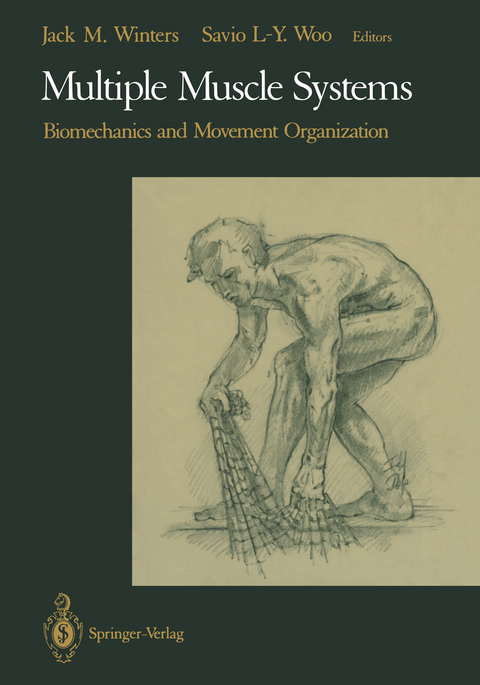
Multiple Muscle Systems
Springer-Verlag New York Inc.
978-1-4613-9032-9 (ISBN)
The picture on the front cover of this book depicts a young man pulling a fishnet, a task of practical relevance for many centuries. It is a complex task, involving load transmission throughout the body, intricate balance, and eye head-hand coordination. The quest toward understanding how we perform such tasks with skill and grace, often in the presence of unpredictable pertur bations, has a long history. However, despite a history of magnificent sculptures and drawings of the human body which vividly depict muscle ac tivity and interaction, until more recent times our state of knowledge of human movement was rather primitive. During the past century this has changed; we now have developed a considerable database regarding the com position and basic properties of muscle and nerve tissue and the basic causal relations between neural function and biomechanical movement. Over the last few decades we have also seen an increased appreciation of the impor tance of musculoskeletal biomechanics: the neuromotor system must control movement within a world governed by mechanical laws. We have now col lected quantitative data for a wealth of human movements. Our capacity to understand the data we collect has been enhanced by our continually evolving modeling capabilities and by the availability of computational power. What have we learned? This book is designed to help synthesize our current knowledge regarding the role of muscles in human movement. The study of human movement is not a mature discipline.
I: Muscle Modeling.- 1. Modeling Muscle Mechanics (and Energetics).- 2. The Charge-Transfer Model of Myofilamentary Interaction: Prediction of Force Enhancement and Related Myodynamic Phenomena.- 3. Modeling of Lengthening Muscle: The Role of Inter-Sarcomere Dynamics.- 4. Architecture and Elastic Properties of the Series Elastic Element of Muscle-Tendon Complex.- 5. Hill-Based Muscle Models: A Systems Engineering Perspective.- 6. Input Identification Depends on Model Complexity.- 7. Actuator Properties and Movement Control: Biological and Technological Models.- II: Modeling Neuromusculoskeletal Movement Systems.- 8. Modeling Musculoskeletal Movement Systems: Joint and Body-Segment Dynamics, Musculotendinous Actuation, and Neuromuscular Control.- 9. Mechanical Impedance of Single- and Multi-Articular Systems.- 10. Linking Musculoskeletal Mechanics to Sensorimotor Neurophysiology.- III: Principles Underlying Movement Organization: Upper Limb.- 11. Principles Underlying Movement Organization: Upper Limb.- 12. The Origin of Electromyograms — Explanations Based on the Equilibrium Point Hypothesis.- 13. Nonlinear Damping of Limb Motion.- 14. Principles Underlying Single-Joint Movement Strategies.- 15. Organizing Principles Underlying Motor Skill Acquisition.- 16. Direction-Dependent Strategy for Control of Multi-Joint Arm Movements.- 17. The Organization of Human Arm Trajectory Control.- 18. The Activation of Mono- and Bi-Articular Muscles in Multi-Joint Movements.- 19. Optimized Strategies for Scaling Goal-Directed Dynamic Limb Movements.- 20. Self-Organizing Neural Mechanisms Possibly Responsible for Movement Coordination.- 21. External Control of Limb Movements Involving Environmental Interactions.- 22. Model-Based, Multi-Muscle EMG Control of Upper-ExtremityProstheses.- IV: Principles Underlying Movement Organization: Spinal Loading and Postural Stability.- 23. Role of Muscle in Postural Tasks: Spinal Loading and Postural Stability.- 24. The Use of Musculoskeletal Models in the Diagnosis and Treatment of Low Back Pain.- 25. Musculoskeletal Function of the Spine.- 26. Postural Biomechanical Stability and Gross Muscle Architecture in the Spine.- 27. Modeling of Muscle Action and Stability of the Human Spine.- 28. Neck Muscle Activity and 3-D Head Kinematics During Quasi-Static and Dynamic Tracking Movements.- 29. Muscle Activation Patterns Coordinating Postural Stability From Head to Foot.- 30. Segmental Movement as a Perturbation to Balance? Facts and Concepts.- 31. Simulation Experiments can Shed Light on the Functional Aspects of Postural Adjustments Related to Voluntary Movements.- 32. Simulation Studies of Musculo-Skeletal Dynamics in Cycling and Sitting on a Chair.- 33. Control of Balance of Upper Body During Gait.- 34. Individual Strategies of Muscle Recruitment in Complex Natural Movements.- V: Principles Underlying Movement Organization: Propulsive and Cyclic Movements with Lower-Limb Emphasis.- 35. Overview: Influence of Muscle On Cyclic and Propulsive Movements Involving the Lower Limb.- 36. The Architecture of Leg Muscles.- 37. Spring-Like Properties of Muscles and Reflexes in Running.- 38. Effects of Muscle Elasticity in Walking and Running.- 39. Muscular Coordination in Sporting Skills.- 40. Analysis of Muscular Work in Multi-Segmental Movements: Application to Cycling.- 41. The Unique Action of Bi-Articular Muscles in Leg Extensions.- 42. An Analytical Framework for Quantifying Muscular Action During Human Movement.- 43. Performing Whole-Body Simulations of Gait with 3-D, Dynamic Musculoskeletal Models.- 44.Adaptability of Motor Patterns in Pathological Gait.- 45. Whole Body Movement: Coordination of Arms and Legs in Walking and Running.- 46. Brain Plans and Servo Loops in Determining Corrective Movements.- Appendix A Survey of Human Musculotendon Actuator Parameters.
| Illustrationen | IDD Delp |
|---|---|
| Zusatzinfo | XX, 801 p. |
| Verlagsort | New York, NY |
| Sprache | englisch |
| Maße | 178 x 254 mm |
| Themenwelt | Medizinische Fachgebiete ► Chirurgie ► Unfallchirurgie / Orthopädie |
| Medizin / Pharmazie ► Physiotherapie / Ergotherapie ► Orthopädie | |
| Studium ► 1. Studienabschnitt (Vorklinik) ► Physiologie | |
| Naturwissenschaften ► Biologie | |
| Technik ► Medizintechnik | |
| ISBN-10 | 1-4613-9032-X / 146139032X |
| ISBN-13 | 978-1-4613-9032-9 / 9781461390329 |
| Zustand | Neuware |
| Haben Sie eine Frage zum Produkt? |
aus dem Bereich


